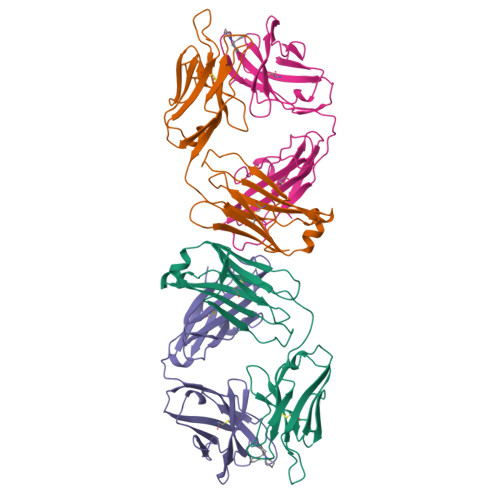Crystal structure of monoclonal 6B5 Fab complexed with phencyclidine.
Lim, K., Owens, S.M., Arnold, L., Sacchettini, J.C., Linthicum, D.S.(1998) J Biological Chem 273: 28576-28582
- PubMed: 9786848
- DOI: https://doi.org/10.1074/jbc.273.44.28576
- Primary Citation of Related Structures:
2PCP - PubMed Abstract:
The crystal structure of monoclonal antibody (mAb) 6B5 Fab fragment complexed with 1-(1-phenylcyclohexyl)piperidine (PCP or phencyclidine) was determined at 2.2-A resolution. 6B5 was originally produced from a mouse immunized with a phencyclidine analogue hapten 5-[N-(1'phenylcyclohexyl)amino]pentanoic acid conjugated to bovine serum albumin. This mAb was selected for further study because of its high affinity (Kd = 2 x 10(-9) M/liter) for PCP and usefulness in reversing PCP-induced central nervous system toxicity in laboratory animals. The dominant feature of the 6B5 Fab.PCP complex is the deep binding site and hydrophobic nature of the interaction. The ligand binding pocket of 6B5 Fab has numerous aromatic side chains, as compared with other known Fab structures. The most notable feature of the binding site is a Trp at position 97H (H-chain), and the side chain of this residue appears to act as a hydrophobic umbrella on the ligand in the antigen binding pocket. There are only two other known Fabs found with a Trp at the 97H position in complementarity determining region (CDR) H3, but they do not play a major role in the interaction with their respective antigens; in both Fab TE33 and R6.5 the Trp 97H side chain is positioned away from the bound antigen. Comparison of the CDR residues of 6B5 with other Fab structures with similar CDR sizes and amino acid compositions reveals a number of important patterns of residue substitutions that appear to be critical for specific PCP ligand interactions.
Organizational Affiliation:
Center for Structural Biology, Department of Biochemistry and Biophysics, Texas A&M University, College Station, Texas, 77843, USA.





















